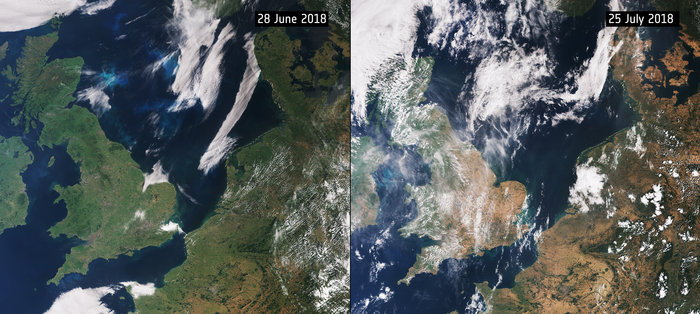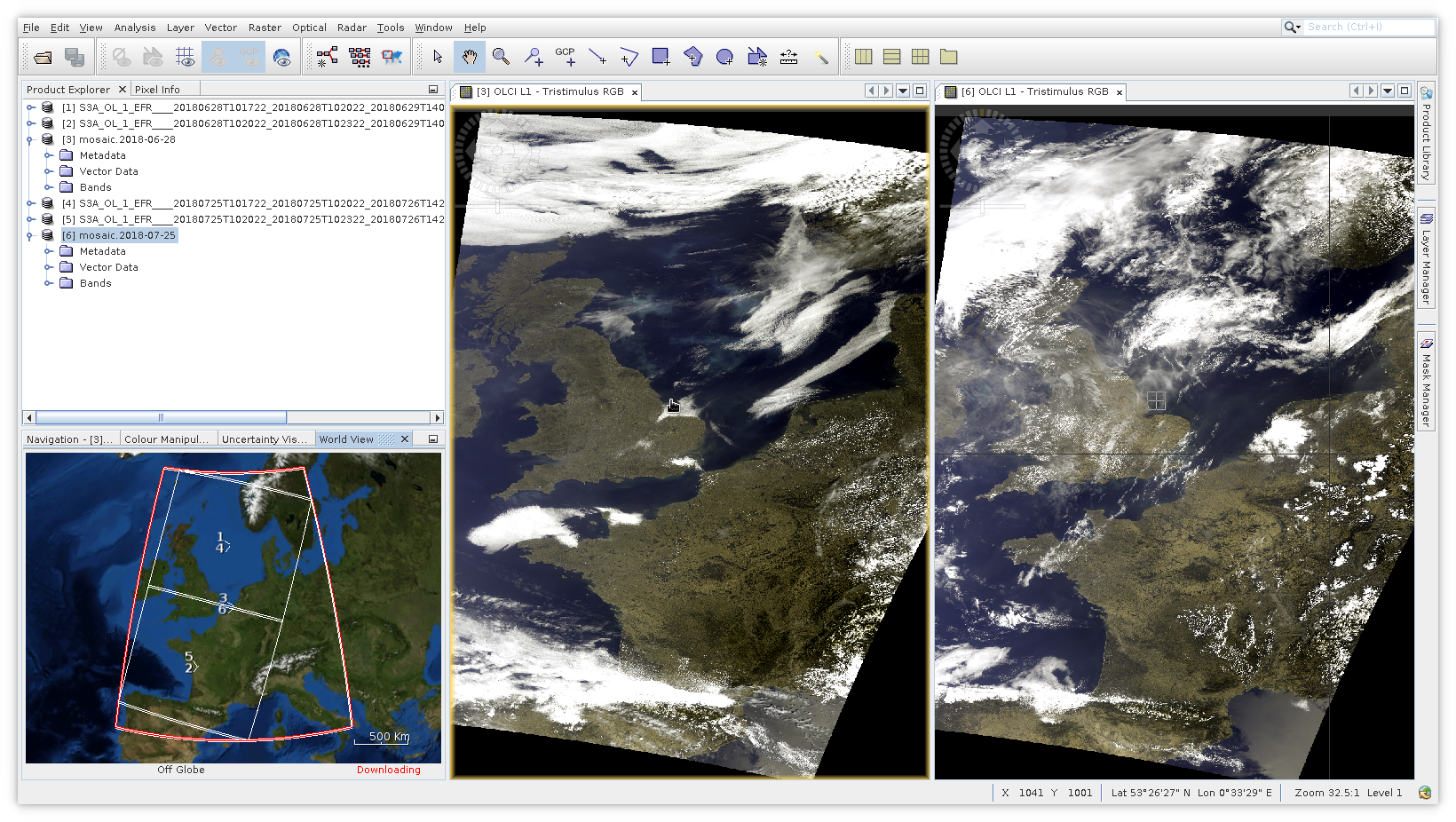At the end of July, a comparison of 2 satellite images taken about a month apart was featured by various news sites, showing how this year’s drought affected vegetation in the landscape during that time. And even though this alone is quite enlightening, I want to look at it from the perspective of referencing primary sources and using open data. Considering the ongoing copyright reform, this is also somewhat topical.
From Green to Brown
This image, based on data from the Sentinel 3 satellite, was published on July 26, 2018 in the Space in Images section of the ESA website as From green to brown in a month, including a summary of what’s shown in the image and a link to a 10MB jpeg in full resolution.

Czech news websites that I managed to find (this is by no means a complete list) picked up this image the following day, July 27, as:
- aktualne.cz: From green to brown. Satellite images revealed how drought changed Europe’s face
- idnes.cz: Scorched continent. Satellites showed how record heat is decimating Europe
- novinky.cz: Sweltering heat afflicts all of Europe (the article uses a different satellite image, but that doesn’t change anything fundamental)
- zive.cz: Europe turned brown: Sentinel-3 satellite photographed it in June and now
- in-pocasi.cz: Western Europe faces heat wave, temperatures reach 38°C
Note that the standard license terms for images from the ESA website do not permit unrestricted commercial use (you will have a problem using it in advertising or if someone is recognizable in the image), but republishing in newspapers, Wikipedia, or on a blog is imho ok, provided you credit ESA as the author of the image, preferably including the satellite name. Btw it’s nice that another license ESA uses for some images is Creative Commons Attribution-ShareAlike 3.0 IGO.
In other words, it’s basically enough to write something like “Image: ESA/Copernicus Sentinel” next to the photo in the article. That said ideally I’d expect to learn:
- That the author is ESA,
- The name of the satellite or satellite constellation (the sheer name is sufficient),
- A link to the original source, that is a URL that helps me to find both the original version of the image and the license under which the image is published (however, if the photo were published under a Creative Commons license, I’d expect a direct link to the license as well).
Of those 5 articles, only zive.cz and in-pocasi.cz did this, while the others at least more or less complied with the license and credited ESA as the source of the image, although:
- aktualne.cz doesn’t mention what satellite it is (on the other hand, the license doesn’t directly require this),
- idnes.cz in the first paragraph also writes that these are aerial images :)
- novinky.cz gives profimedia.cz as the source, which is somewhat strange …
And this makes me wonder: Why is it such a problem nowadays to include a full link to the source in an internet article? I understand that back when newspapers only came out on paper, it simply wasn’t possible to reference sources better, but today a reader often has online access to the source as easy as the author. This seems to me like some historical relic, or laziness. The author doesn’t save much work and it only reduces their credibility, because it’s not possible to:
- get an idea of whether the author of the article actually used the primary source
- look up details if the article interests me (eg. in this case I might want to download the original high-resolution version)
- find out under what license the source is available (eg. so I could use the photo further in accordance with the license, for instance for another similar comparison), without having to ask the author of the article (who doesn’t actually hold the copyright to that photo anyway)
- verify claims in the article (here for example how newspapers interpreted the photo compared to what ESA claims)
- directly search for articles based on the source used (e.g., I might be interested in whether someone else used the same source in a different context)
But to be clear, I don’t expect journalists to search for and link to internet sources for every trivial matter, when much of the verification and journalistic work in general doesn’t happen on the internet. But if they’re already working with some non-trivial information that they obtained via the internet and it is available to anyone, why not link to it? Moreover, if an author has already used some source, it seems unprofessional not to cite it or mention it without a full link. On the other hand, if the author doesn’t cite a source because they don’t actually know it, there’s no point discussing any trustworthiness.
Copernicus Sentinel
The reason why it’s useful to know which satellite the image comes from is that within the Copernicus Programme, which includes the Sentinel satellites, a large portion of the acquired data is freely available. The license of this data then allows you to do anything with it, provided you reference the Copernicus Sentinel project in the prescribed format and indicate whether you have modified or processed the data in any way.
This caught my attention, so I thought I’d try to download the source satellite data for the image that went through the newspapers in July. Maybe later I’ll devote a separate post to a detailed description of how I downloaded the data and tried to process it (i.e., at least display it somehow). However, it quickly became apparent that this isn’t exactly straightforward. Nevertheless, it’s nice that this data is available this way, including documentation and various tutorials, and that the software ESA develops for processing this data is licensed under GPLv3.
On the one hand the images I managed to get from the data don’t have as high resolution as they theoretically could and on top of that look a bit strange, but on the other hand I did an uncrop wrt the media famous picture, because it turned out it was composed of 2 consecutive satellite images :-)

Czech Radio Article
The availability of data from Sentinel satellites was later utilized for example by Czech Radio, which on August 9 puslished an article titled Less green, more brown. Compare how this year’s and last year’s summer look from space in the Czech Republic. This is imho the most interesting of all the articles about this year’s drought based on Sentinel satellite data, but it also must have required the most work. And not just because the images in the article show the Czech Republic and not Britain. If you want to read any of those articles, read this one.
And it probably won’t surprise anyone that they have described the data sources correctly, exactly according to the license :) If anyone was puzzled that I don’t mind the absence of an HTML link to the original source here, in this case it’s ok because the satellite images used in the radio article aren’t directly taken from some website, but were provided by a Czech GIS company (which among other things processes Sentinel data), so no such URL exists.
From the Copyright Reform Perspective
And finally, I’d allow myself a small digression. As you have probably noticed, in September the European Parliament voted on the copyright reform proposal without significant amendments. So unless all the nonsense there gets thrown out during the trilogue (which isn’t very likely, quite the opposite) or the European Parliament throws the whole thing off the table eventually, we still realistically face various not entirely pleasant outcomes soon.
In the context of this post, the funniest part probably is that if the articles linked above were automatically indexed by an upload filter when published, I might well have problems publishing this post on information society service provider storing and providing access to the public to large amounts of copyright protected work. Despite the fact that I use data in accordance with the license and link to the primary source, while most newspaper articles don’t. But how could the upload filter recognize that?
In a similar way, I’d probably have problems with links to the articles because I used a large part of the title in them. So I’d either have to buy the appropriate license or use the URL as the link text. I allowed myself to reject the possibility of inventing a new title for each article to avoid the obligation to license it. But in this case it probably doesn’t matter anyway, because if bulk automated processing of articles were restricted, I wouldn’t even be able to find which articles used that satellite image in the given time period, and so I wouldn’t have anything to link to.
<irony> I can already see how this will help to fight misleading news, help to increase publishers’ profits, and improve media quality in general. Maybe it wouldn’t be a bad idea to also require newspapers to use the same upload filter before publishing articles for further improvement of the situation. </irony>